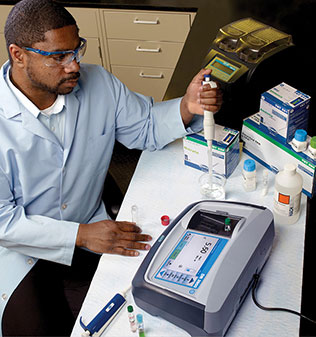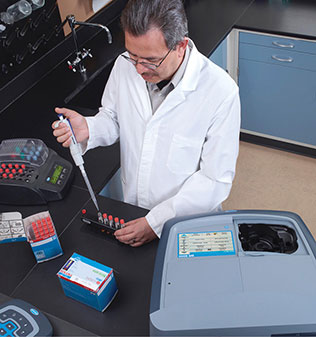-
Products
-
실험실제품
- 미터와 프로브
- 시약과 스탠다드
-
Microbiology
Accessories and Chemicals Dehydrated Media InstrumentsLabware Prepared Media
-
온라인제품
나트륨 EZ Series Analysers
- 철
- Aluminium
- Manganese
- Phosphate
- Chloride
- Cyanide
- Fluoride
- Sulphate
- Sulphide
- Arsenic
- Chromium
- Copper
- Nickel
- Zinc
- Ammonium
- 총 질소(TN)
- 총 인(TP)
- Phenol
- Volatile Fatty Acids
- 알칼리도
- ATP
- 경도
- Toxicity
- 샘플 사전 조정
- Boron
- Colour
- Nitrate
- Nitrite
- Silica
- Hydrogen Peroxide
- EZ Series Reagents
- EZ Series Accessories
- EZ sc Series Inorganics
- EZ sc Series Metals
- EZ sc Series Nutrients
- 온라인 제품 센서 및 컨트롤러
- Multiparameter Online Panels
-
실험실 관련 장비
General Lab Consumables Glassware/PlasticwareSafety Equipment
- 테스트 키트
- Automated Lab Systems
- Industrial UV
- Electrochemistry
-
실험실제품
- Industries
- Support
- Parameters
- WQ Platform
- About Us
Korea, South
Choose your country or region:
Europe
Americas
Asia - Australasia
- Australia
- Mainland China
- India
- Indonesia
- Japan
- Malaysia
- New Zealand
- Philippines
- Singapore
- South Korea
- Thailand (Thai)
- Taiwan
- Vietnam
Middle East - Africa
02-3484-5700
휴대용, 실험실용 및 UV-VIS 분광광도계
언제나 믿을 수 있는 수질 테스트
관련 규제 준수 및 안정적인 플랜트 운영 가능
반 세기가 넘는 동안 Hach(하크)는 분광광도계로 수질 분석을 위한 최상의 파트너로 자리잡았습니다.
- 다수의 승인된 실험 방법 적용 가능
- 특허받은 에러 보호 기능 내장
- 시장을 선도하는 Hach(하크)의 화학 물질과 호환 가능
- 모든 적용분야 및 예산을 충족하는 휴대용 및 실험실용 솔루션 제공
분광광도계란 무엇일까요?
분광광도계는 빛이 투과할 때 물 샘플이 얼마나 많은 빛을 흡수하는지를 측정하는 장비입니다.
물 샘플에 화학물질을 첨가한 후, 이러한 시약들이 물 복합체를 형성하며 피분석물과 반응합니다. 그런 다음 분광광도계는 내부 보정 기능을 사용하여, 해당 색상을 측정 중인 파라미터의 농도와 동일시합니다.
분광광도기술은 다양한 산업 및 공공 적용 분야에서 다양한 물의 항목을 양적으로 분석하는 가장 일반적이고 유용한 방법 중 하나입니다.
분광광도계 종류
정확도 높은 Hach(하크)의 시약과 함께 Hach(하크)의 휴대용 또는 탁상용 분광광도계 (VIS 또는 UV-VIS)를 선택할 수 있습니다. 이를 통해 최적의 수질을 보장할 수 있습니다.

휴대용 분광광도계
휴대가 가능한 한 손으로 들고 다닐 수 있는 분광광도계는 현장에서 물 샘플을 분석하는 데 용이합니다.
주로 이동이 잦은 환경에서 작업을 수행한다면, Hach(하크)의 휴대용 분광광도계는 견고하고 컴팩트하며 사용자 친화적인 패키지로 정확한 측정 결과와 품질을 보장합니다.

실험실용 분광광도계
실험실용 분광광도계는 전자기 스펙트럼의 시각적 범위를 통해 빛의 흡수 정도를 측정합니다. 많은 양의 수질 분석에 이상적입니다.
사용자 친화적인 탁상용 분광광도계는 실험실에서의 수질 분석에 적합하도록 250개가 넘는 측정 방법이 사전 프로그래밍되어 있습니다.

UV-VIS 실험실용 분광광도계
UV-VIS 실험실용 분광광도계는 전자기 스펙트럼의 자외선 및 가시 범위에서 빛의 흡광도를 측정합니다.
Hach(하크)의 UV-VIS 분광광도계는 측정 방법을 단계별로 안내하며, 사전에 프로그램된 실험 방법이 내장되어 있습니다. 또한 필요한 경우 Hach(하크)에서 제공하는 워터 인텔리전스 시스템인 Claros™와 연동하여 품질을 보장받을 수 있습니다.
분광광도계 주요 제품 라인업
휴대용 분광광도계
간편한 사용자 인터페이스로 이전보다 쉬운 측정이 가능해졌습니다. DR1900은 최고 수준의 정확도와 휴대성을 자랑합니다.
가볍고 컴팩트한 DR1900은 견고함이 요구되는 환경에서도 이상적으로 사용할 수 있습니다. 또한 바이알 사이즈도 광범위하게 적용할 수 있어 유연한 적용이 가능합니다.
또한 가장 일반적으로 사용되는 220개가 넘는 측정 방법이 사전 프로그래밍된 상태로 내장되어 있습니다.
실험실용 분광광도계
DR3900 실험실용 분광광도계 - RFID* 기술 미적용
DR3900 은 가시 스펙트럼 범위 (320 - 1100 nm)를 적용하는 탁상용 분광광도계입니다. 분할 빔 방식의 분광광도계로 실험실 내 수질 분석에 최적화된 220개가 넘는 사전 프로그래밍된 방법이 내장되어 있습니다. 이를 통해 안정적인 실험 방법으로 정확한 결과를 얻을 수 있습니다.
장비와 Hach(하크)의 혁신적인 워터 인텔리전스 시스템인 Claros™를 연결하면 눈에 보이지 않는 연결을 통해 측정기, 데이터 및 공정을 언제 어디서나 관리할 수 있습니다.
자세히 보기UV-VIS 분광광도계
DR6000™ UV-VIS 분광광도계 - RFID 기술 미적용
탁상용의 UV-VIS (190 - 1100 nm) 대역의 분할 빔 분광광도계로 UV 및 가시 스펙트럼을 통한 파장 스캔 기능을 지원합니다. 빠른 스캔 속도가 특징입니다.
산업현장에서 가장 고급 기술이 적용된 실험실용 분광광도계로 250개가 넘는 사전 프로그래밍된 방법이 내장되어 있습니다. 이 장비도 Claros™와 연동할 수 있습니다.
자세히 보기e-러닝 과정으로 교육 기회를 만나보세요!

전문가가 지도하는 트레이닝 강좌를 찾아보세요. 디지털 강의 과정은 분광광도계 장비에 대한 분명한 이해를 돕고, 수질 분석에 대한 전문성을 키워줄 것입니다.
Frequently Asked Questions
What is the difference between a colorimeter and a spectrophotometer?
Colorimeters (also referred to as Filter Photometers) and Spectrophotometers both measure sample absorbance to determine analyte concentrations. Colorimeters are usually portable and use LED light sources and color filters. As a result, they operate at fixed wavelengths and can only accommodate tests that incorporate those wavelengths.
Spectrophotometers are usually bench top instruments and use light sources that can produce a range of wavelengths. The spectrophotometers used by Hach use tungsten (or xenon) lamps to produce light in the visible spectrum and deuterium lamps to produce UV light. Spectrophotometers also use monochromators to select for a desired wavelength. As a result, spectrophotometers can be used for a broad range of tests.
The following table highlights the differences between Colorimeters and Spectrophotometers:
| Colorimeter (Filter Photometer) | Spectrophotometer |
|
| Light Source | LED, Fixed Wavelength | Lamp (Tungsten, Xenon, Deuterium), Wavelength Range |
| Wavelength Selector | Color Filter, Fixed Wavelength | Monochromator, Wavelength Range |
| Portability | Stationary parts, light weight, good for field use | Moving parts, heavier, good for bench use. The DR1900 can be used in the field. It is lighter and battery operated, but still has some moving parts. |
| Parameters | Single or Limited Number of Parameters determined by Fixed Wavelengths | Numerous Parameters determined by the Wavelength Range. |
How is a calibration curve prepared in a colorimeter or spectrophotometer?
Hach colorimeters and spectrophotometers are carefully calibrated during manufacturing and do not require additional calibration. However, most of these instruments have user-entered calibration options for colorimetric tests if desired.
To calibrate an instrument for a particular test, put the instrument in absorbance mode, select the wavelength for the test, and prepare 3 to 10 different concentrations of standard solutions that span the full test range. Follow the Hach procedure (or your own procedure) to develop color in each standard, and the measure the absorbance of each standard in the instrument.
Most Hach instruments can record the absorbance and concentration of each standard, and then calculate a calibration curve. Refer to the instrument manual for instrument specific instructions. After the instrument is calibrated, it will calculate the concentration of unknown samples using the calibration curve.
What is the difference between the DR3900 and DR6000 Spectrophotometers?
The DR6000 spectrophotometer has a UV lamp while the DR3900 spectrophotometer does not. As a result, there are more programs on the DR6000 than on the DR3900.
The DR6000 has a Carousel Holder 7 x 1 cm (Product # LZV902.99.00002) and a Carousel Holder 5 x 1 inch (Product # LZV902.99.00012), which can be purchased as optional accessories.
The DR6000 also has optional software applications which are not available on the DR 3900. These include the Brewery Analysis Package (Product # LZV942), the Drinking Water Analysis Package (Product # LZV925), and the Enzymatic Food Analysis Software (Product # LZV943).
The DR6000 has tighter specifications than the DR3900. For example, the wavelength accuracy of the DR6000 is ± 1 nm. The wavelength accuracy of the DR3900 is ± 1.5 nm.
What is the factor to convert from PO4 to PO4-P?
To convert from units of orthophosphate (PO43-) to orthophosphate as phosphorus (PO4-P), multiply the value by 0.3261. To convert from orthophosphate as phosphorus (PO4-P) to orthophosphate (PO43-) divide the value by 0.3261.
Many Hach spectophotometers and colorimeters give the option to change the chemical form of the reported value. This number is a ratio of the atomic mass of the elements in the chemical form. This calculation does not change the concentration of phosphorus in the sample, it only changes the value in relation to the units it is expressed in.
For example: Changing a height from 6 feet to 72 inches, or to 183 cms, does not change the actual height, it only changes the units in which it is reported. They are all mathematically equivalent.
Are the DR3900 and DR6000 spectrophotometers compatible with WiFi/WLAN?
The spectrophotometer has a wired ethernet connection out of the box. In order to connect a DR3900 or DR6000 spectrophotometer to a WiFi Network/WLAN, a USB adapter must be used. Hach does not carry an adapter; however, adapters based off of RealTek RTL8187, such as Netgear WG111v3 and Trendnet TEW-424UB H/W:3.1R have been found to work.
Does Hach have an ultra-low range iron procedure for spectrophotometers?
Iron, Total FerroZine® Method, Method 10287_DOC316.53.01520 measures ultra-low range iron using FerroZine® and a standard 1" square glass sample cell on the DR3900, DR5000, or DR6000.
Why does a spectrophotometer need to be zeroed?
Spectrophotometers and colorimeters are zeroed or "blanked" to reset the absorbance baseline to any background color in the sample that may absorb at the wavelength in question causing an interference.
What is the advantage of using RFID with spectrophotometers?
The Radio Frequency Identification (RFID) system is designed to deliver accurate results by supporting the operator from sampling to sample preparation, sample analysis and documentation. By means of RFID technology one can trace samples completely back to the sampling point.
Lot number and expiry date information of the TNTPlus™ tests are logged into the spectrophotometer thanks to the 2D barcode. The RFID module reads out and displays all batch specific information from the test box. The batch certificate can be printed out immediately from the spectrophotometer using a printer.
Which instruments are compatible with TNT+ vials?
The DR1900, DR3900, and DR6000 are compatible with TNT+ chemistries.
To verify vial compatibility with any instruments please verify that the instrument is listed in the Instrument-specific information table in the full version of the method document.
Can the temperature of a sample affect a colorimetric test?
Yes this is possible. For example, a colder temperature could slow the chemical reaction and cause low results. Most methods are completed accurately when the sample temperature is between 20 and 25 ° C (68 to 77 °F).
Methods which are extremely temperature sensitive will have a note regarding any special temperature requirements in the full procedure.
What is the enclosure rating for Hach Spectrophotometers and Colorimeters? Enclosure ratings are denoted with an IP code that designates the resistance of an instrument to dust and water intrusion.
The first digit signifies the resistance to solid particles while the second digit signifies the resistance to liquid ingress. An "X" in the IP rating signifies the enclosure was not rated for that specification.
As an example, an IP-67 rating means that an instrument is dust proof and is waterproof for up to 30 minutes at a depth of 1 meter. Included in this article is a table of IP ratings for Hach Spectrophotometers and Colorimeters.
| Instrument | Rating | Other Information |
| DR 6000 | IP-20 | With the sample cell compartment closed |
| DR3900 | IP-40 | Excluding USB and Ethernet Ports and power supply |
| DR1900 | IP-67 | With the sample cell compartment closed |
| DR5000 | IP-31 | |
| DR3800 | IP-3X | |
| DR2800 | IP-41 | With the sample cell compartment closed, IP-42 with Protective Cover in place |
| DR2700 | IP-41 | |
| DR800 | IP-67 | |
| DR900 | IP-67 | Including the USB port. USB port should not be used when wet. |
| PCII | IP-67 | Excluding the battery compartment |
What information do the DR3900 and DR6000 Spectrophotometers read on the TNT+ boxes with RFID?
The TNT+ box includes updates to the calibration factors, including zero factors, as well as the Certificate of Analysis (COA). This information is read by DR3900 and DR6000 Spectrophotometers via RFID.
Which Hach spectrophotometers can read ultraviolet wavelengths?
The DR6000 UV VIS Spectrophotometer is the only current Hach spectrophotometer with a UV lamp to read samples in the ultraviolet spectrum.
What Are the Differences Between DR6000 and DR3900 and Which One Is Best Suited for My Lab?
The key difference between the Hach DR6000 and the Hach DR3900 spectrophotometers lies in their capabilities and features. The Hach DR6000 spectrophotometer has a higher wavelength range than the Hach DR3900 spectrophotometer, with a range of 190-1100 nm compared to the DR3900's range of 320-1100 nm. Additionally, the DR6000 has a higher resolution than the DR3900, making it more suitable for advanced research applications.
On the other hand, DR3900 spectrophotometer is equipped with RFID technology that simplifies calibration procedures, making it a popular choice for routine laboratory testing. This powerful instrument can also measure multiple parameters simultaneously, which is a valuable feature for labs that need to perform multiple tests on a single sample.
When it comes to choosing the best-suited spectrophotometer for a lab, the decision will depend on the lab's specific needs and applications. If the lab requires a high level of accuracy and resolution for advanced research purposes, the Hach DR6000 would be the better choice. On the other hand, if the lab needs a spectrophotometer for routine testing with a simple calibration process and simultaneous measurement capabilities, the Hach DR3900 would be a more practical option.
How does a Portable Spectrophotometer help?
DR1900 portable spectrophotometer is a cutting-edge instrument designed for field measurements of water quality. Its portable design allows for quick and convenient measurements of critical parameters, such as chlorine, pH, and dissolved oxygen, ensuring accurate data collection for water quality analysis.
One of the key benefits of the DR1900 is its rugged construction, which makes it ideal for use in harsh environmental conditions. Its waterproof design allows it to be used in wet environments, and it is drop-tested to ensure it can withstand accidental drops.
The DR1900 Portable Spectrophotometer also has a user-friendly interface, which makes it easy to operate even for those without extensive technical knowledge. The instrument's large, backlit display ensures that results can be easily read, even in low-light environments.
Another significant advantage of the DR1900 is its versatility. It can measure over 120 different water quality parameters, including ammonia, nitrate, and phosphorus. The DR1900 also has a unique cuvette holder that allows for testing of large sample sizes, which is critical for applications such as wastewater treatment.
Overall, the DR1900 portable spectrophotometer is an invaluable tool for water quality testing. Its rugged design, ease of use, and versatility make it an ideal choice for environmental and water quality professionals who require accurate and reliable data in the field.
Read more about the features here: https://in.hach.com/family-print.pdf.jsa?productCategoryId=22216799358
How does a Spectrophotometer in lab work?
The fundamental principle behind spectrophotometry is the Beer-Lambert Law, which states that the concentration of a sample is directly proportional to the amount of light absorbed by the sample. When a beam of light passes through a sample, some of the light is absorbed, and the remainder is transmitted. The spectrophotometer measures the amount of light that is transmitted and calculates the amount that was absorbed.
Hach DR3900 spectrophotometer is a highly advanced instrument that uses a dual-beam design for accurate and reliable measurements. The dual-beam design ensures that the intensity of the incident light and the optical path length of the instrument does not affect the accuracy of the measurements. Our DR3900 spectrophotometer can measure absorbance at wavelengths ranging from 190 to 1100 nm, making it a versatile instrument for a range of applications.
One of the key features of the Hach DR3900 spectrophotometer is its ability to measure multiple parameters simultaneously, reducing the time and cost of analysis. Additionally, the instrument is equipped with RFID technology, which allows for quick and easy calibration of the instrument, ensuring accurate measurements every time.
Applications of the Hach DR3900 Spectrophotometer
The Hach DR3900 Lab Spectrophotometer is commonly used in various fields, including environmental testing, wastewater analysis, and industrial quality control. The instrument can measure various parameters, including pH, conductivity, and dissolved oxygen.
In environmental testing, the instrument is used to measure pollutants in water and air samples. In wastewater analysis, it is used to measure the quality of wastewater before and after treatment. In industrial quality control, the instrument is used to ensure the consistency and quality of products.





